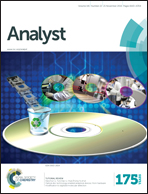Förster resonance energy transfer to impart signal-on and -off capabilities in a single microRNA biosensor†
Abstract
Many studies have found that over- or under-expression of biomolecules called microRNAs (miRNA) regulates several diseases. Biosensors are in need to visually identify the relative expression level of miRNA to determine the direction these miRNA change in cells and tissues. Our established reporter+probe miRNA biosensor design requires that miRNA outcompete and displace the reporter from the probe. Once displaced, the reporter folds into a hairpin structure to force together a pair of Förster Resonance Energy Transfer (FRET) dyes. The donor and acceptor signal changes can be used to indicate the over-/under-expression of miRNA. The bright signal from the donor will indicate miRNA under-expression; the bright acceptor signal will indicate miRNA over-expression. Since close proximity of the dyes to each other and nucleic acids often quench fluorescence, polyethylene glycol spacers were added in-between the dyes and nucleic acids. We compared reporter designs with and without spacers to investigate the effects on the following analytical metrics: (1) extent of signal change, (2) limits of detection and quantitation, and (3) sensitivity. Systematic errors and amount of reporter+probe biosensor formed were evaluated for one of the biosensors. Cy3|Cy5 and 6-carboxyfluorescein (6-FAM)|ATTO 633 dye pairs on reporters containing spacers showed an increase in the acceptor signal change by ∼190 and ∼484%, respectively, compared to no spacers. Transduction mechanisms that enhance and quench the signal both showed LODs that ranged from 3–17 nanomolar (nM) with 100 nM of the biosensor.


 Please wait while we load your content...
Please wait while we load your content...